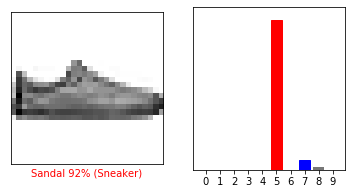from __future__ import absolute_import, division, print_function, unicode_literals
import tensorflow as tf
from tensorflow import keras
import numpy as np
import matplotlib.pyplot as plt
print(tf.__version__)
2.0.0
导入Fashion MNIST 数据集
数据集包含70000灰度图片,10个分类
每张图片的像素为28*28
60000张图片作为训练集,10000张图片作为测试机
fashion_mnist = keras.datasets.fashion_mnist
(train_images, train_labels), (test_images, test_labels) = fashion_mnist.load_data()
class_names = ['T-shirt/top', 'Trouser', 'Pullover', 'Dress', 'Coat',
'Sandal', 'Shirt', 'Sneaker', 'Bag', 'Ankle boot']
train_images.shape
(60000, 28, 28)
len(train_labels)
60000
train_labels
array([9, 0, 0, ..., 3, 0, 5], dtype=uint8)
test_images.shape
(10000, 28, 28)
len(test_labels)
10000
plt.figure()
plt.imshow(train_images[0])
plt.colorbar() # 颜色渐变条
plt.grid(False) # 不添加网格线
plt.show()

数据预处理。图片的像素值范围在0-255,为了使输入数据值在0-1之间,将原始值除以255.0
train_images = train_images / 255.0
test_images = test_images / 255.0
plt.figure(figsize=(10,10))
for i in range(25):
plt.subplot(5,5,i+1) # 将图片划分为5行5列
# 控制每个图片的边框刻度
plt.xticks([])
plt.yticks([])
plt.imshow(train_images[i], cmap=plt.cm.binary) # 黑白图片
plt.xlabel(class_names[train_labels[i]])
plt.show()

# 建立网络架构
model = keras.Sequential([
keras.layers.Flatten(input_shape=(28, 28)), # 输入数据向量化
keras.layers.Dense(128, activation='relu'), # 添加全连接层
keras.layers.Dense(10, activation='softmax')
])
# 定义正则化、损失函数
model.compile(optimizer='adam',
loss='sparse_categorical_crossentropy',
metrics=['accuracy'])
model.fit(train_images, train_labels, epochs=10) # 训练网络
Train on 60000 samples
Epoch 1/10
60000/60000 [==============================] - 9s 149us/sample - loss: 0.4946 - accuracy: 0.8247
Epoch 2/10
60000/60000 [==============================] - 7s 116us/sample - loss: 0.3722 - accuracy: 0.8654
Epoch 3/10
60000/60000 [==============================] - 7s 114us/sample - loss: 0.3353 - accuracy: 0.8776
Epoch 4/10
60000/60000 [==============================] - 7s 115us/sample - loss: 0.3116 - accuracy: 0.8846
Epoch 5/10
60000/60000 [==============================] - 8s 126us/sample - loss: 0.2951 - accuracy: 0.8914
Epoch 6/10
60000/60000 [==============================] - 7s 111us/sample - loss: 0.2809 - accuracy: 0.8975
Epoch 7/10
60000/60000 [==============================] - 7s 110us/sample - loss: 0.2716 - accuracy: 0.8988
Epoch 8/10
60000/60000 [==============================] - 7s 118us/sample - loss: 0.2560 - accuracy: 0.9050
Epoch 9/10
60000/60000 [==============================] - 7s 122us/sample - loss: 0.2456 - accuracy: 0.9077
Epoch 10/10
60000/60000 [==============================] - 9s 143us/sample - loss: 0.2385 - accuracy: 0.9110
<tensorflow.python.keras.callbacks.History at 0x29df5dfa780>
test_loss, test_acc = model.evaluate(test_images, test_labels, verbose=2)
print('\nTest accuracy:', test_acc)
10000/1 - 1s - loss: 0.3204 - accuracy: 0.8783
Test accuracy: 0.8783
predictions = model.predict(test_images)
predictions[0]
array([1.2773737e-08, 1.6460965e-09, 1.2608050e-08, 2.2927955e-10,
8.7082235e-09, 1.5253473e-04, 7.7240850e-07, 5.0626141e-03,
1.9821150e-07, 9.9478382e-01], dtype=float32)
np.argmax(predictions[0])
9
test_labels[0]
9
def plot_image(i, predictions_array, true_label, img):
predictions_array, true_label, img = predictions_array, true_label[i], img[i]
plt.grid(False)
plt.xticks([])
plt.yticks([])
plt.imshow(img, cmap=plt.cm.binary)
predicted_label = np.argmax(predictions_array)
# 预测正确标记为蓝色,错误则为红色
if predicted_label == true_label:
color = 'blue'
else:
color = 'red'
# 横轴上分别为 预测的分类名,预测分类的可能性,正确分类名
plt.xlabel("{} {:2.0f}% ({})".format(class_names[predicted_label],
100*np.max(predictions_array),
class_names[true_label]),
color=color)
def plot_value_array(i, predictions_array, train_labels):
predictions_array, true_label = predictions_array, train_labels[i]
plt.grid(False)
plt.xticks(range(10))
plt.yticks([])
# 直方图横坐标0-9,纵坐标对应每个分类的得分
thisplot = plt.bar(range(10), predictions_array, color="#777777")
plt.ylim([0, 1])
predicted_label = np.argmax(predictions_array) # 预测的分类标签
thisplot[predicted_label].set_color('red') # 预测分类的纵坐标标注为红色
thisplot[true_label].set_color('blue') # 正确分类的纵坐标标注为蓝色
# 第一张图片的预测结果
i = 0
plt.figure(figsize=(6,3))
plt.subplot(1,2,1)
plot_image(i, predictions[i], test_labels, test_images)
plt.subplot(1,2,2)
plot_value_array(i, predictions[i], test_labels)
plt.show()

# 第13张图片的预测结果
i = 12
plt.figure(figsize=(6,3))
plt.subplot(1,2,1)
plot_image(i, predictions[i], test_labels, test_images)
plt.subplot(1,2,2)
plot_value_array(i, predictions[i], test_labels)
plt.show()

num_rows = 5
num_cols = 3
num_images = num_rows*num_cols
plt.figure(figsize=(2*2*num_cols, 2*num_rows))
for i in range(num_images):
plt.subplot(num_rows, 2*num_cols, 2*i+1) # 每个数据预测结果的第一张图片
plot_image(i, predictions[i], test_labels, test_images)
plt.subplot(num_rows, 2*num_cols, 2*i+2) # 每个数据预测结果的第一张图片
plot_value_array(i, predictions[i], test_labels)
plt.tight_layout() # 会自动调整子图参数,使之填充整个图像区域
plt.show()

img = test_images[1]
print(img.shape)
(28, 28)
# 图片添加进空的数据集,这个数据集只有一个数据
img = (np.expand_dims(img,0))
print(img.shape)
(1, 28, 28)
predictions_single = model.predict(img)
print(predictions_single)
[[8.1730264e-05 7.7724135e-16 9.9977332e-01 2.8166874e-10 1.3929847e-04
1.6422478e-14 5.6340227e-06 3.3765748e-19 8.4485353e-12 6.8645493e-16]]
plot_value_array(1, predictions_single[0], test_labels)
_ = plt.xticks(range(10), class_names, rotation=45)

np.argmax(predictions_single[0])
2






















 2207
2207











 被折叠的 条评论
为什么被折叠?
被折叠的 条评论
为什么被折叠?








